Excavations at the Church of the Holy Sepulchre in Jerusalem have revealed 2,000-year-old plant remains that may be from the ancient garden mentioned in the biblical Gospel of John.
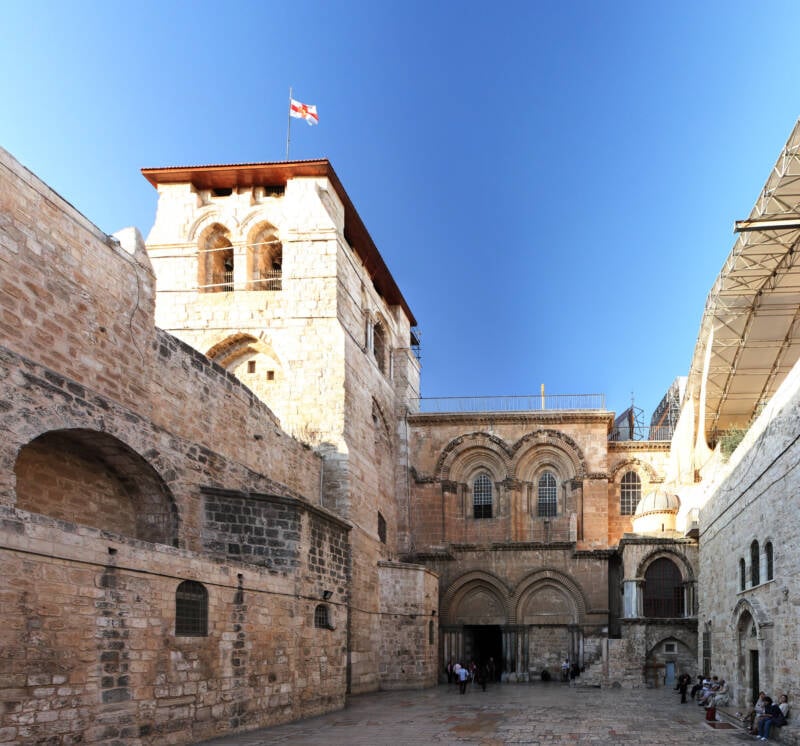
askii/Flickr The Church of the Holy Sepulchre, where Jesus is believed to have been buried.
In John 19:41, the Bible states that Jesus was crucified and buried near a garden just outside the city walls of Jerusalem. Now, archaeologists excavating the Church of the Holy Sepulchre believe they may have identified it.
Since 2022, researchers have had the rare privilege of studying one of Christianity’s most sacred sites. Beneath the church’s ancient stone floors, they have uncovered a wealth of artifacts, including pottery, coins, and other items dating from the Iron Age to the Crusades.
Recently, they uncovered the most significant finding yet: plant material from olive trees and grape vines dating back 2,000 years, around the time of Jesus’ death. The finding has provided support for biblical accounts of Jesus’ crucifixion and burial, offering a direct connection to the events described in Scripture.
The History Of The Church Of The Holy Sepulchre
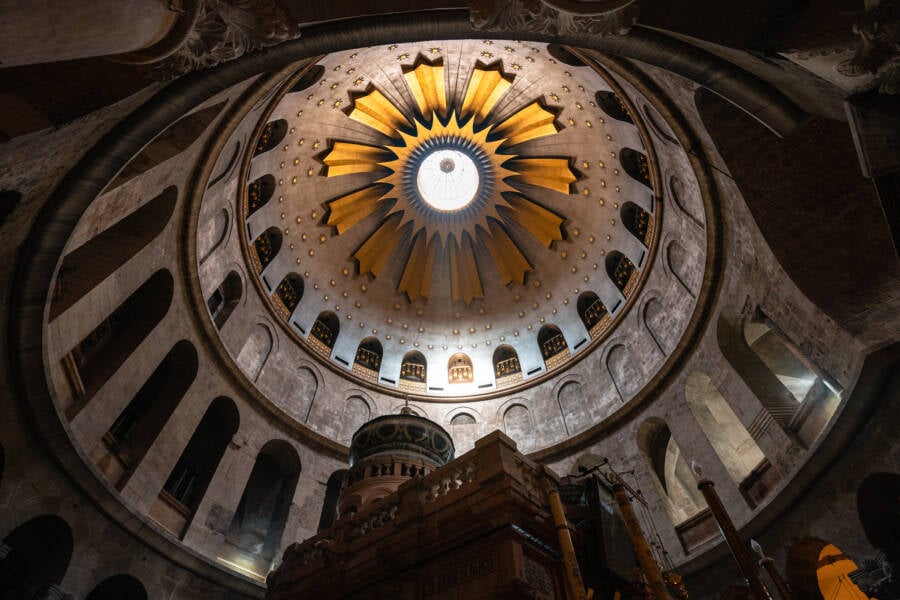
Adam Cohn/Flickr The Church of the Holy Sepulchre’s interior dome.
Believed to be the site of Jesus’ crucifixion, the Church of the Holy Sepulchre in the Old City of Jerusalem welcomes millions of pilgrims every year.
Its influence as a holy place in Christianity dates as far back as the fourth century, when Roman Emperor Constantine the Great ordered a pagan temple on the site to be turned into a church. During the building’s construction, workers discovered an old tomb that they believed was that of Jesus Christ.
Since then, it’s been widely believed the church was built on the site of Jesus’ crucifixion and tomb. Today, it is one of the holiest places in all of Christianity.
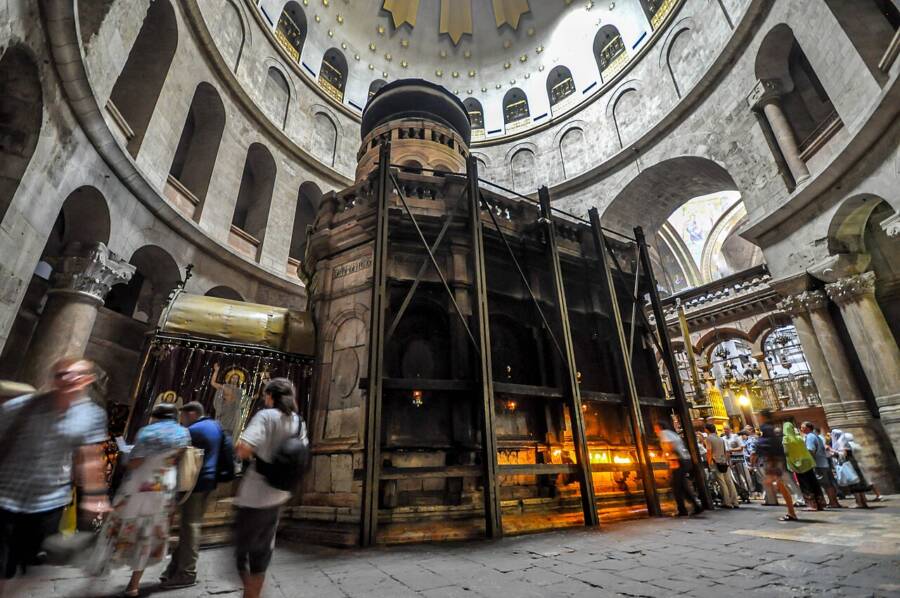
Jlascar/Wikimedia CommonsThis structure surrounds what is purportedly the original tomb of Jesus in the Church of the Holy Sepulchre, where he was allegedly buried in the Shroud of Turin.
With its impressive historical background, the church has served as a focal point for archaeologists and historians. Since 2022, archaeologists, geologists, archaeobotanists, and archaeozoologists have been excavating the church and studying its artifacts, looking to piece together its long history.
In addition to traditional excavation methods, tools like 3D mapping and radar are helping researchers visualize the church’s layers and structures without disturbing the delicate site. These technologies can create detailed digital reconstructions of the building and its surroundings, essentially compiling a complete historical timeline.
“While we have not been able to see the entire church excavated in one glance, new technologies are allowing us to reconstruct the bigger picture in our labs,” Professor Francesca Romana Stasolla of the Sapienza University of Rome, the leader of the excavations, told the Times of Israel. “If we were talking about a puzzle, we could say we are only excavating one piece at a time, but eventually, we will have a complete multimedia reconstruction of the full picture.”
Recently, these excavations revealed an important finding beneath the stone floor of the church — one that lends further support to the biblical account of Jesus’ burial.
Archaeologists Uncover An Ancient Garden Under The Church’s Floor
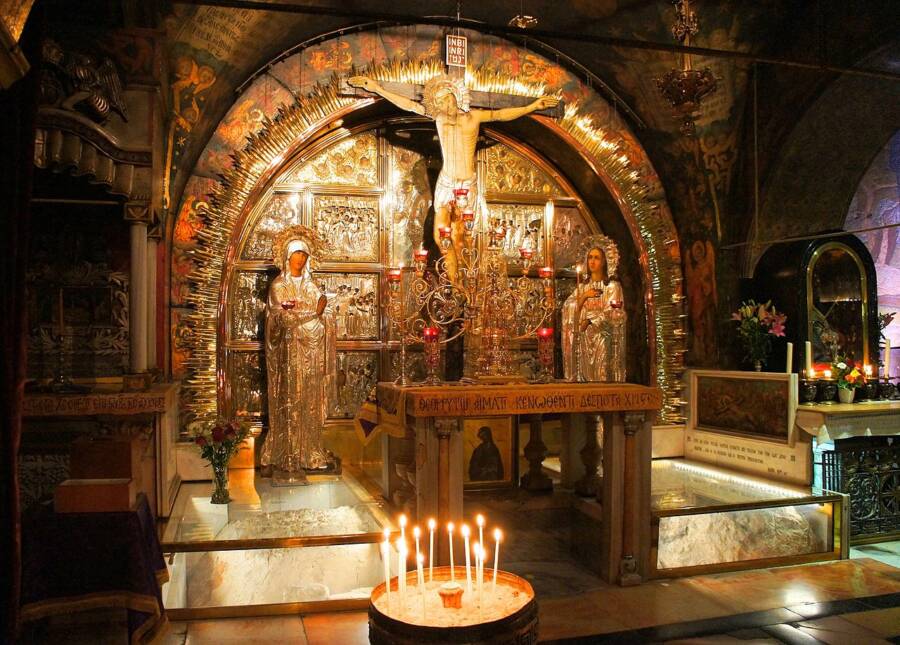
Ondřej Žváček/Wikimedia CommonsThis altar marks the alleged spot where Jesus’ cross was raised during his crucifixion.
In 2022, researchers led by Stasolla were granted permission from the Orthodox Patriarchate, the Custody of the Holy Land, the Armenian Patriarchate, and the Israel Antiquities Authority to conduct excavations at the Church of the Holy Sepulchre.
During their work, archaeologists uncovered pottery, glass, oil lamps, stone walls, and even forgotten Crusade-era altars. However, perhaps the most significant finding was made only recently.
Researchers performed archaeobotanical analysis on soil taken from beneath the church’s stone floor and found seeds and pollen from olive trees and grape vines. While radiocarbon dating is still in process, these plant remains seemingly date back approximately 2,000 years, around the time of Jesus’ death.
Remarkably, the Bible mentions a garden near Jesus’ burial. John 19:41 and 19:42 read: “Now in the place where he was crucified there was a garden; and in the garden a new sepulchre, wherein was never man yet laid. There laid they Jesus therefore because of the Jews’ preparation day; for the sepulchre was nigh at hand.”
Researchers believe these plant findings may point to the existence of an ancient garden beneath the church, providing physical evidence that aligns with the scriptural description.
“The archaeobotanical findings have been especially interesting for us, in light of what is mentioned in the Gospel of John,” Stasolla told the Times of Israel. “The Gospel mentions a green area between Calvary [or Golgotha, the site of Jesus’ crucifixion] and the tomb, and we identified these cultivated fields.”
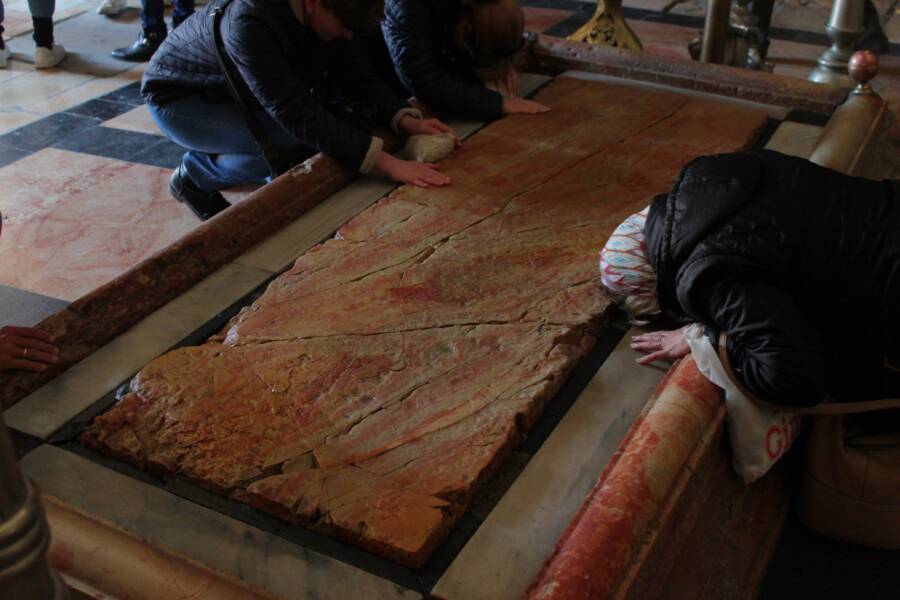
Robbie Hott/Flickr Pilgrims pray at the stone where Jesus is believed to have been anointed.
While the archaeologists await the results of radiocarbon dating on the plant material, they have turned their attention to other areas of the church, particularly those constructed during the reign of Constantine. Once this year’s Easter festivities conclude, the team plans to continue excavations for several more months before shifting focus to the analysis and publication of the findings.
Despite ongoing debate over whether the church is indeed the site of Jesus’ death and burial, the archaeologists stress that their goal is not to settle this religious dispute. Instead, their work aims to uncover the story of the pilgrims who have visited the church throughout history.
“Whether someone believes or not in the historicity of the Holy Sepulchre, the fact that generations of people did is objective,” Stasolla explained. “The history of this place is the history of Jerusalem, and at least from a certain moment, it is the history of the worship of Jesus Christ.”
After reading about the ancient garden at the Church of the Holy Sepulchre, dive into the story of the Holy Grail and the centuries-long quest to find it. Then, read about the search for the Ark of the Covenant, the ancient vessel believed to have held the original Ten Commandments.





